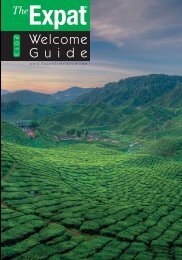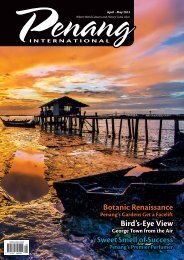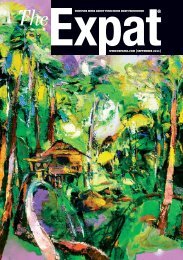Celebrate Heritage! Hidden Retreat The Road ... - The Expat Group
Celebrate Heritage! Hidden Retreat The Road ... - The Expat Group
Celebrate Heritage! Hidden Retreat The Road ... - The Expat Group
Create successful ePaper yourself
Turn your PDF publications into a flip-book with our unique Google optimized e-Paper software.
architecture<br />
Cultural<br />
Fusion<br />
Penang owes its rich culture<br />
and architectural splendor to<br />
the various races that found a<br />
home on the island during its<br />
years as a port. Kat Fatland<br />
admires the diverse styles<br />
and designs these infl uences<br />
brought to her home city’s<br />
architecture.<br />
IN THE 2008 INSCRIPTION jointly<br />
establishing George Town and Melaka as<br />
World <strong>Heritage</strong> Sites, UNESCO states that<br />
these two towns “constitute a unique<br />
architectural and cultural townscape<br />
without parallel anywhere in East and<br />
Southeast Asia.”<br />
Upon a first read, the statement seems<br />
impossibly bold: after all, there are a<br />
myriad of architecturally interesting cities<br />
all over the region, what could possibly<br />
make Penang and its sister city so special?<br />
<strong>The</strong> answer, in short, is quite a bit. From<br />
Malay kampungs to Anglo Indian bungalows,<br />
from Chinese shophouses to Colonial-style<br />
churches, Penang’s list of international<br />
influences is all-encompassing. Like much<br />
of its heritage, the island’s architectural<br />
style reflects the serendipitous outcome of<br />
cultures coming together.<br />
People and Penang<br />
Penang’s architectural history could be<br />
said to have truly begun in 1786 when<br />
it became a British trading post. Thanks<br />
in part to founder Francis Light’s good<br />
relations with locals and regional traders,<br />
settlers started moving to the island en<br />
masse, coming from Arabia, Siam, India and<br />
China, Indonesia, and mainland Malaya.<br />
Soon, the city could boast a core group of<br />
permanent residents who began to set up<br />
shop throughout the island.<br />
Penang happened to be in a very unique<br />
position to cater to the settlers’ wishes<br />
to bring with them something of their<br />
homeland. Unlike the surrounding areas,<br />
where systems of government could<br />
implement strictures on foreign or local<br />
architectural influence (in nearby Kedah,<br />
for example, no one could build a house<br />
taller than the Sultan’s palace), Penang<br />
could accommodate a host of diverse<br />
customs. Thus, the Indian traders brought<br />
with them their Anglo-Indian traditions,<br />
the Chinese brought their courtyard<br />
houses, and the Europeans brought their<br />
neoclassicist designs.<br />
Adaptation<br />
Smartly, instead of producing replicas<br />
of buildings from their country of<br />
origin, builders took note of what local<br />
Malay houses had to offer and adapted<br />
accordingly. Perfectly suited for the<br />
tropical climes, the typical Malay house<br />
was constructed largely from timber and<br />
atap. <strong>The</strong> houses were stilted to provide<br />
ample ventilation to the rooms above, and<br />
a sloping atap roof offered shade over the<br />
verandah. <strong>The</strong>se features, along with the<br />
building materials, were largely borrowed<br />
by other traditions as they went about<br />
building their own abodes.<br />
<strong>The</strong> Penang bungalow is a particularly<br />
apt example of the blending of many<br />
traditions into one regal household. <strong>The</strong><br />
bungalow, derived from the Hindi term<br />
bungla, originally came to the island via<br />
India. <strong>The</strong>re, the bungalow was a simple<br />
four-walled structure made of mud and<br />
later brick with a low, sweeping roof. <strong>The</strong>se<br />
structures were commonly built for the<br />
lower class, while the upper class resided in<br />
the colonial-style pucka houses, characterised<br />
by their flat roofs, a form exemplified in<br />
Penang’s Suffolk house.<br />
When the bungalow reached Penang<br />
however, it lost all low-class connotations.<br />
Here, the buildings were recreated using<br />
Indian brick masonry and Malay-style<br />
timber. <strong>The</strong> form became popular among<br />
the families of Indian and Arab traders<br />
– the Jawi Peranakans – who chose to<br />
group together their bungalows in typical<br />
Malay kampungs (a term that gave birth<br />
to the English word “compound”). <strong>The</strong><br />
Europeans, who also found the form useful,<br />
married the Malay and Indian traditions<br />
with their own traditions, building huge<br />
two-storey bungalows with well-ventilated<br />
stilted verandahs, sweeping rooftops,<br />
20 Penang International







